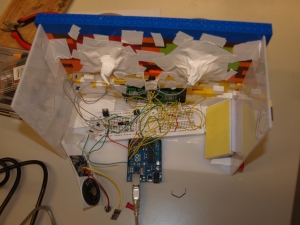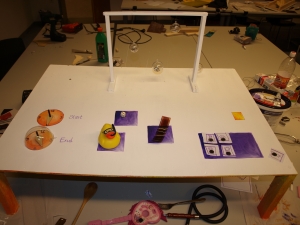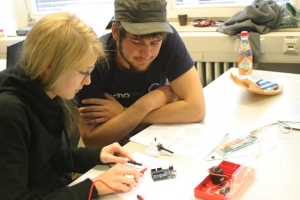On Friday, we invited some people to our course to present our projects. Here is a short description of each project. For detail explanation please goto the specific sites.
Coffee Timer
Verena Lerch and Frederik Brudy
In every office around the globe there is the same problem every day over and over again: People try working hard and every once in a while they need a break. So why not go for a coffee with their colleagues and catch up with the latest office information. So usually you open up your e-mail program, send a quick note and wait for reply from your co-workers. Soon, you will get about ten or fifteen replies from your colleagues, every single one with a different opinion about what the perfect timing would be. Often it really gets annoying and coffee-break-mails tend to be treated as spam messages. If one finally manages to find the perfect timing so everyone is happy soon you realize that at least one colleague has been left out of the mail and all the timing stuff starts all over again. Lots of precious working time is lost.This is where our CoffeeTimer kicks in: It is a fast and easy way to time your coffee break. CoffeeTimer saves time and stops the annoyance of finding the right timing to have a break and catch up in an unstressed atmosphere.
Interactive Wardrobe
Anna Follmann | Beatrix Vad
In our project we developed an Interactive Wardrobe. Imagine an ordinary wardrobe, but with additional communication features and integrated enhanced light design. Users can record audio messages for currently absent people and the wardrobe plays the message as soon as the returning person hangs up his / her jacket. In addition the light design visualizes the current state of the wardrobe, e.g. left messages are indicated by colored lights.
Spare Time Manager
Verena Hillgaertner and Bernhard Hering
Our project was the idea of designing a Spare Time Manager. It’s an new, interactive way to coordinate your leisure time with your friends. You only have to choose your three favorite spare time activities, the start and ending time which is best for you, also your friends you want to spend them with. Those friends will have to do the same, and after a short time, the Free Time Manager will calculate the time and activity, witch suits all friends best.
The Interactive Doormat
Chadly Marouane
Johannes Preis
In our project, we present an ìinteractive doormatî. The main purpose of the mat is to enhance the experience when entering ones home. This is accomplished by letting the users enter a personal symbol combination on the mat with their feet while providing visual feedback on a back-illuminated display. Upon recognizing a user via the entered symbol combination, user specific feedback is provided (here: playing the users favorite song). In an alternative mode, the mat is used as a controller for a little memory game (similar to ìSimon Saysî).
Lego Alarm Clock
Kyung-Jin Park
Lorenz Schauer
Our project we are going to present is an alarm clock with LEGO. When the alarm goes on one of the lights starts to blink and it shows on which color bricks you have to plug in the white LEGO bricks (you can find them on the right side). With the nose you can change the display (if it’s on or off). To switch-off the light, the sound and the spray (which has a awkward scent) you have to plug LEGO bricks on the right colors. If you do so the light, the spray and the sound goes off and a little hook on the left side gives you a sign that you’ve done right.
Robocat
Robert Rödler
Maraike Stuffler
In our globalized world it has become very usual to have a long-distance relationship. Of course two people living far away from each other miss physical contact, or can’t even fall asleep without the other one. Indeed they are able to see each other via webcam, but they have no options to snuggle or hug, because personal computers aren’t very cuddly. They also could talk on the phone, but at the cost of their facial expression, which makes communication – in particular emotional communication – difficult. We worked out a solution for that missing part: “Robocat”, a soft toy, which you can take with you and snuggle with when you’re going to sleep, which can be used to communicate to the other person just by playing with it, and which shows you the mood of the other person. Robocat brings haptic and audible fun in long-distance relationships and banishs loneliness!
We say thank you, to our supervisior Raphael and Alexander, for their help and ispiration.



































